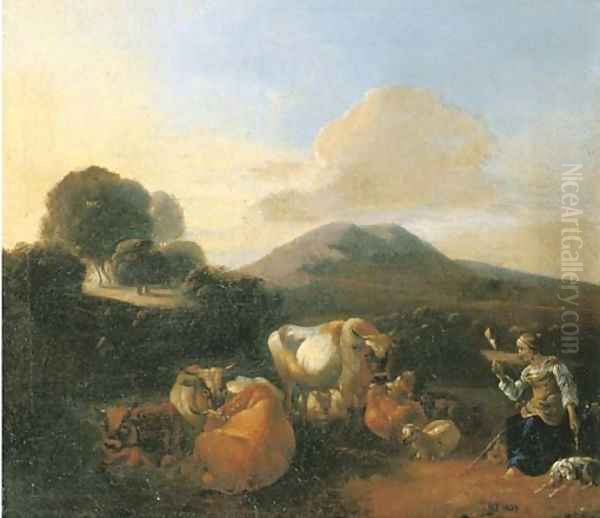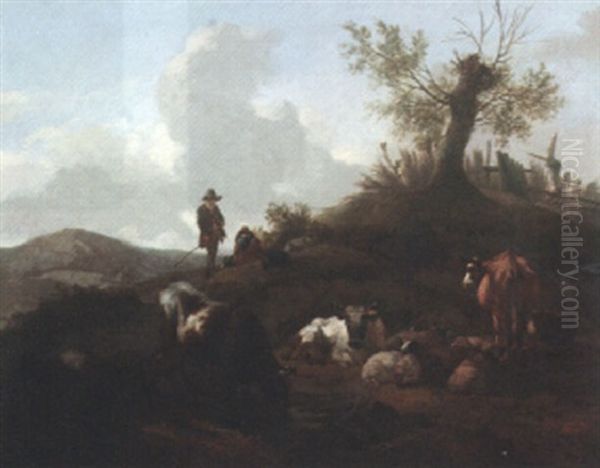Willem Romeyn (c. 1624–1694) stands as a notable figure within the rich tapestry of the Dutch Golden Age of painting. A native of the Netherlands, specifically the vibrant artistic hub of Haarlem, Romeyn dedicated his career to capturing the serene beauty of landscapes, particularly those infused with the warm light and pastoral charm associated with Italy. As both a painter and a skilled printmaker, he contributed significantly to the popular Italianate style that captivated Dutch artists and patrons throughout the 17th century. His works are characterized by their peaceful atmosphere, meticulous rendering of animals, and sensitive handling of light, securing his place among the respected landscape specialists of his era.
Early Life and Artistic Formation in Haarlem
Born around 1624 in Haarlem, Willem Romeyn entered the world during a period of unprecedented artistic flourishing in the Dutch Republic. Haarlem itself was a crucible of creativity, home to renowned masters and a thriving art market. It was in this stimulating environment that Romeyn took his first steps towards an artistic career. Crucial to his development was his apprenticeship under Nicolaes Pietersz. Berchem (1620–1683), one of the most celebrated and prolific Dutch Italianate painters.
Romeyn is documented as being a student of Berchem around 1642. Berchem's influence was profound, instilling in Romeyn a love for sun-drenched southern landscapes, populated with shepherds, peasants, and, most notably, livestock. Berchem's own works, often depicting lively scenes within idealized Italian settings, provided a strong foundation upon which Romeyn would build his own distinct style. Following his training, Romeyn achieved professional recognition by joining the prestigious Haarlem Guild of St. Luke as a master painter in 1646. This membership signified his competence and allowed him to practice independently, take on commissions, and potentially train pupils.
The Italianate Style and Romeyn's Vision

The Italianate movement was a significant trend in 17th-century Dutch art. Artists, either having travelled to Italy or inspired by the works of those who had, sought to capture the perceived idyllic beauty, classical ruins, and unique golden light of the Italian countryside (the Campagna). This contrasted with the often flatter, cooler-toned landscapes of their native Netherlands. These paintings offered Dutch patrons, many of whom were wealthy merchants and burghers, an escape into a romanticized, pastoral world.
Willem Romeyn became a dedicated practitioner of this style. While it is uncertain whether Romeyn himself ever travelled to Italy, his paintings masterfully evoke a southern atmosphere. His landscapes are typically bathed in a warm, golden or hazy sunlight, creating long shadows and highlighting the textures of the scene. Unlike some Italianate painters who focused on dramatic mountain vistas or bustling harbour scenes, Romeyn favoured more tranquil, pastoral settings.
His compositions are often characterized by a sense of harmony and balance. He typically arranged gentle, rolling hills, perhaps punctuated by a classical ruin, a rustic farmhouse, or a cluster of trees, creating a peaceful backdrop for his primary subjects. Water, often in the form of a stream or a quiet pond where animals drink, frequently features, adding to the serene mood and allowing for reflections that enhance the play of light.
Focus on Animals and Pastoral Life
A defining characteristic of Willem Romeyn's oeuvre is his exceptional skill in depicting animals, particularly cattle, sheep, and goats. These creatures are rarely mere accessories in his landscapes; they are often the central focus, rendered with careful observation and empathy. He captured their forms, postures, and textures with remarkable fidelity – the rough hide of a resting cow, the woolly fleece of a sheep, the alert stance of a goat.
His paintings frequently depict scenes of everyday pastoral life: shepherds and shepherdesses tending their flocks, cattle resting in shaded pastures during the heat of the day, or animals watering at a stream. The human figures in his works are usually peasants or herders, depicted simply and integrated naturally into the landscape. They contribute to the overall idyllic atmosphere rather than dominating the scene. This focus aligns with the broader Dutch interest in genre scenes but transports them to an idealized, sunnier clime.

Compared to his teacher Berchem, Romeyn's work often possesses a quieter, more contemplative quality. While Berchem's scenes can be lively and filled with anecdotal detail, Romeyn often favoured moments of repose and tranquility. His compositions might be less complex, focusing on a smaller group of animals or a simpler landscape arrangement, allowing the viewer to appreciate the subtle interplay of light, form, and atmosphere. His touch could be described as somewhat softer and more delicate than the sometimes more robust handling of Berchem or the crisp clarity found in the works of Karel Dujardin (c. 1622–1678), another prominent Italianate painter with whom Romeyn's work shares thematic similarities.
Representative Works
While a comprehensive catalogue of Romeyn's work is still evolving, several paintings exemplify his characteristic style and subject matter. Titles often vary, but common themes persist:
"Italianate Landscape with Shepherds and Cattle": This title represents a core theme. Such works typically showcase a sunlit clearing or hillside, perhaps near ancient ruins or simple Italianate buildings. Shepherds, often depicted resting or quietly observing, accompany carefully rendered cattle and sheep basking in the warm light. The emphasis is on the peaceful coexistence of humans, animals, and nature within an idealized southern setting.
"Cattle in a Pasture": Paintings focusing primarily on cattle highlight Romeyn's skill as an animal painter. He excelled at capturing the placid nature of cows, depicting them resting, grazing, or drinking. The landscape serves as a harmonious backdrop, often featuring soft light filtering through trees or reflecting off water.
"Southern Landscape with Travellers Resting": Occasionally, Romeyn included figures beyond shepherds, such as travellers pausing on a journey. These scenes maintain the pastoral calm, with the figures integrated into the landscape alongside their animals, reinforcing the theme of harmony between humanity and the natural world in an idealized setting.
His works demonstrate a consistent sensitivity to light and atmosphere, a hallmark of the best Dutch landscape painting, applied here to the Italianate mode. The warm tonality and careful rendering of textures, from animal hides to foliage and stone, are characteristic features.
Romeyn in the Context of the Dutch Golden Age
Willem Romeyn worked during a period of extraordinary artistic production in the Netherlands. The Dutch Republic, having gained independence and achieved significant economic prosperity, fostered a unique art market. Patronage shifted from the Church and aristocracy towards a burgeoning middle class – merchants, guild members, and wealthy citizens – who desired art for their homes. This led to a specialization among artists and the popularity of genres reflecting everyday life and the Dutch environment, including portraits, still lifes, genre scenes, and landscapes.
Within landscape painting, several trends coexisted. Some artists, like Jacob van Ruisdael (c. 1628–1682) – a fellow Haarlem native and arguably the greatest Dutch landscape painter of the era – focused on the dramatic or tranquil beauty of the Dutch countryside itself. Others, like Meindert Hobbema (1638–1709), specialized in wooded scenes. Marine painters like Willem van de Velde the Younger (1633–1707) captured the nation's maritime power.
The Italianate painters formed another distinct and popular group. Besides Romeyn and his teacher Berchem, key figures included Jan Both (c. 1618–1652) and Jan Asselijn (c. 1610–1652), who were pioneers in bringing the Italian light back to the Netherlands. Karel Dujardin, Adam Pynacker (1622–1673), and Jan Baptist Weenix (1621–c. 1660) were also highly successful contemporaries working in similar veins, each with their own nuances. Romeyn operated within this specific niche, contributing his particular vision of pastoral serenity.
Haarlem, where Romeyn spent much of his life, was a major centre alongside Amsterdam, Delft, Leiden, and Utrecht. It was the home base of the great portraitist Frans Hals (c. 1582–1666) and genre painters like Adriaen van Ostade (1610–1685) and Jan Steen (c. 1626–1679), although Steen also worked elsewhere. The presence of such diverse talents created a dynamic artistic milieu. Romeyn's connection to Berchem and his membership in the Guild placed him firmly within this active Haarlem scene, even as his subject matter looked southward.
Printmaking Activities
Beyond his paintings, Willem Romeyn was also recognized as a printmaker, specifically an etcher. Etching was a popular medium during the Dutch Golden Age, allowing artists to reproduce their designs and reach a wider audience. Many painters, including Rembrandt van Rijn (1606–1669) and Adriaen van Ostade, were also master etchers.
Romeyn's etchings likely echoed the themes found in his paintings: pastoral landscapes populated with animals and shepherds. Printmaking required strong draughtsmanship, a skill evident in the careful structure and detail of his painted works. His activity as an etcher would have further disseminated his style and contributed to the popularity of Italianate scenes among collectors who might not afford paintings. The exact extent and influence of his printmaking output warrants further study but confirms his versatility as an artist.
Career, Recognition, and Later Life
Willem Romeyn appears to have spent most, if not all, of his working life based in Haarlem. He was active from the mid-1640s until near his death in 1694. His works found favour with collectors during his lifetime, fitting well with the prevailing taste for idealized landscapes. The quality of his animal painting, in particular, was likely a strong selling point.
Despite his contemporary success, Romeyn's name perhaps faded slightly in subsequent centuries compared to the very top tier of Dutch masters like Rembrandt, Vermeer (1632–1675), Hals, or Ruisdael. This might be partly due to the sheer number of talented landscape painters active during the Golden Age, including many working in the Italianate style. Changing artistic tastes in the 18th and 19th centuries also played a role, with periods favouring different styles or subjects. Furthermore, as noted in some sources, a relative lack of extensive critical study or dramatic biographical details may have contributed to his somewhat quieter reputation in later art history.
However, his work was never entirely forgotten. His paintings continued to be appreciated by connoisseurs and entered important collections. Today, works by Willem Romeyn can be found in major museums across Europe, including the Rijksmuseum in Amsterdam, the Alte Pinakothek in Munich, the Gemäldegalerie in Berlin, and other public and private collections, attesting to his enduring quality.
Details about his later life and potential students remain somewhat scarce. While his teacher Berchem is known to have had numerous pupils, Romeyn is less documented as a major instructor. Some obscure names have occasionally been linked to him, but establishing definitive master-pupil relationships beyond his own training with Berchem is difficult. He passed away in Haarlem, likely in 1694, leaving behind a body of work that continues to charm viewers with its peaceful beauty.
Legacy and Influence
Willem Romeyn's primary contribution lies within the Dutch Italianate landscape tradition. He was a skilled and sensitive interpreter of the pastoral ideal, creating harmonious compositions bathed in warm, evocative light. His particular strength in rendering animals, especially cattle, places him among the notable animal specialists of the Dutch Golden Age.
While perhaps not as innovative or influential as pioneers like Jan Both or versatile masters like Berchem, Romeyn perfected a specific vision of tranquil, sunlit pastoral life. His paintings offered an appealing escape for Dutch viewers, transporting them to a serene, idealized world far removed from the often-grey skies and bustling commerce of the Netherlands.
His influence may be seen less in direct pupils and more as part of the collective impact of the Italianate style, which remained popular well into the later 17th century and influenced landscape painting traditions elsewhere in Europe. His dedication to careful observation, particularly of animals, and his ability to create a palpable sense of peace and warmth ensure his continued appreciation among those who study and admire Dutch Golden Age art. He remains a fine example of the specialized mastery that characterized this remarkable period in art history.